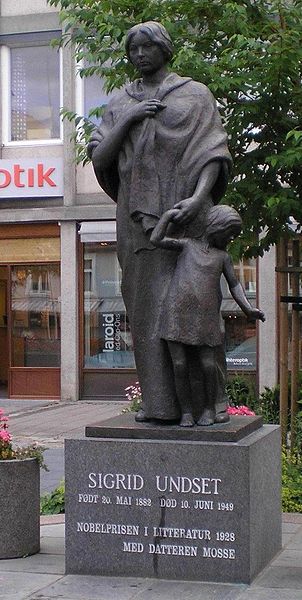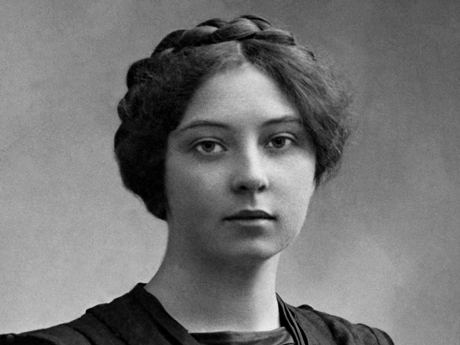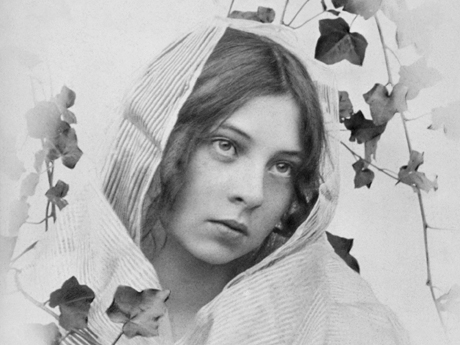<Back to Index>
- Economist Frédéric Passy, 1822
- Writer Sigrid Undset, 1882
- King of Iraq Faisal bin Hussein bin Ali al-Hashemi, 1883
PAGE SPONSOR
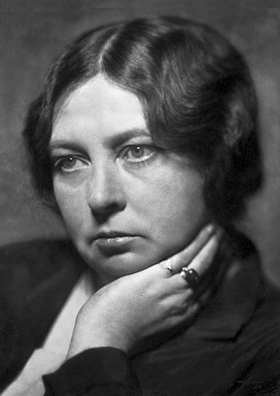
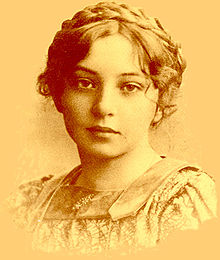
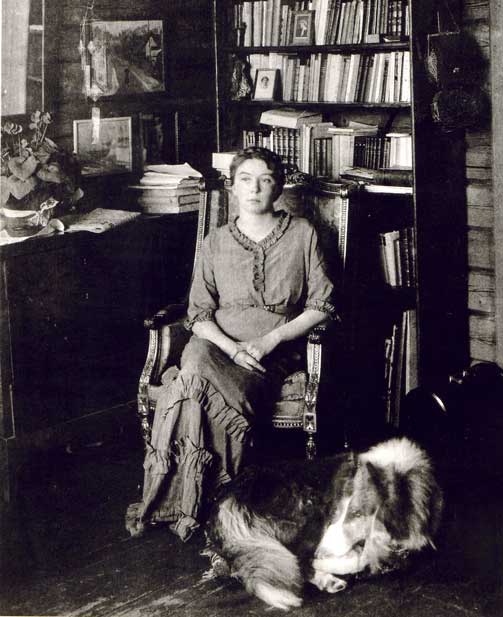
Sigrid Undset (20 May 1882 – 10 June 1949) was a Norwegian novelist who was awarded the Nobel Prize in Literature in 1928.
Undset was born in Kalundborg, Denmark, but her family moved to Norway when she was two years old. In 1924, she converted to Catholicism and became a lay Dominican. She fled Norway for the United States in 1940 because of her opposition to Nazi Germany and the German occupation, but returned after World War II ended in 1945. Her best known work is Kristin Lavransdatter, a modernist trilogy about life in Scandinavia in the Middle Ages. The book was set in medieval Norway and was published from 1920 to 1922 in three volumes. Kristin Lavransdatter portrays
the life of woman from birth until death. Undset was awarded the Nobel
Prize in Literature for this trilogy as well as her two volume work
about Olav Audunssøn known as The Master of Hestviken tetralogy, published in 1925 and 1927. Undset experimented with modernist tropes such as stream of consciousness in her novel, although the original English translation by Charles Archer excised many of these passages. In 1997, the first volume of Tiina Nunnally's new translation of the work won the PEN / Faulkner Award for Fiction in the category of translation. The names of each volume were translated by Archer as The Bridal Wreath, The Mistress of Husaby, and The Cross, and by Nunally as The Wreath, The Wife, and The Cross. Sigrid Undset was born on 20 May 1882, at Kalundborg, Denmark,
at the handsome childhood home of her mother, Charlotte Undset
(1855 - 1939), on the market place of the small town. Sigrid was the
eldest of the couple's three daughters. She came to Norway at the age
of two, when her parents moved on account of her father's illness,
which forced him to give up further scientific travel in Europe. She grew up in Kristiania, the capital (the name was changed back to Oslo in
1924). The first eleven years of her life were strongly influenced by
her father's serious illness but also by his extensive historical
knowledge. At an early age, Sigrid learned not only the secrets of archaeology, but also the mysteries of the Norse sagas and Scandinavian folk songs. When she was only 11 years old, her father the noted archaeologist, Ingvald Martin Undset (1853 - 1893), died at the age of 40. Her
mother was left to cope single handedly with three young daughters, on
very slim means. This family tragedy left its mark on Sigrid Undset's childhood and adolescence. Her hopes of a university education had to be abandoned. Having passed the intermediate school (Middelskole) examination, she took a one year secretarial course, and, at the age of 16, got a job as secretary with a major German owned engineering company in Kristiania.
It was necessary for her to earn money to help her mother and her two
younger sisters. She worked with the same company for 10 years as a
secretary, gradually assuming a highly trusted position. There were
times when she detested office work, feeling she was wasting her time
and her youth. But it gave her insight into a major industrial
enterprise, taught her how to work systematically, and made her into an
expert typist. She later exhibited a considerable talent for organisation, both as housewife and subsequently as chairman of
the Society of Norwegian Authors. Furthermore, systematic office
routine undoubtedly taught her a good deal about how to proceed with
major literary works such as her serial novels. But
the ten years of office work were a torment to Sigrid Undset. Late at
night, and during weekends and holidays, she stole the time to write.
Sigrid was no more than 16 years old when she made her first hesitant
attempt at writing a novel set in the Nordic Middle Ages. For several years, she wrestled with the subject. At the same time, she
read a lot, acquiring a thorough knowledge of Nordic as well as foreign literature, English in particular. She was deeply moved by Shakespeare, enthusiastic about Chaucer's The Canterbury Tales, and attracted by legends of King Arthur. But she also immersed herself in the work of Scandinavian writers, such as Ibsen, August Strindberg, and Georg Brandes. She was also a great admirer of British authors such as the Brontë sisters and Jane Austen.
On her own initiative and in her spare time she thus acquired a sound
knowledge of the art of writing, preparing herself for what she felt
from an early age to be her "fate" in life. The
manuscript of Undset's first novel was ready by the time she was 22. It
was the result of burning the midnight oil for many years. It was an historical novel set in Medieval Denmark, clearly of the romantic school. The manuscript was turned down by the publishing house, and to Undset this was a devastating blow. All the same, two years
later, she had completed another manuscript; much less voluminous this
time, only 80 pages. She had put aside the Middle Ages, and had instead
produced a realistic description of a woman with a petit bourgeois background in contemporary Kristiania. The title was Fru Marta Oulie,
with an opening sentence which scandalised the readers: "I have been
unfaithful to my husband." These were the words of the book's main
character. This book was also refused at first, but after the
intervention of a well known writer of the time, it was subsequently
accepted. Thus, at the age of 25, Sigrid Undset made her literary debut with a short, realistic novel on adultery,
set against a contemporary background. It created a stir, and she found
herself ranked as a promising young author in Norway. During the years
up to 1919, Undset published a number of novels set in contemporary
Kristiania. The 10 years at the office had been lonely and difficult
ones, but they had given her a foothold in the world of unimportant,
everyday people; those who bravely, if not necessarily heroically,
strove to find some happiness in life. Undset was a shy, rather introverted young
woman with few personal friends. But she had unusually sharp eyes, she
saw people, and she saw through them. Her way of breaking out of her loneliness was
to take long strolls in and around Kristiania, both east and west, and
she came to know it better than most. Her contemporary novels of the
period 1907 - 1918 include all this — the city and its insignificant
inhabitants, the monotonous boarding house existence
of secretaries in a gloomy town, their longing for a little warmth and
love, and their brave, not to say heroic, rejection of seediness. These
are the stories of working people, of trivial family destinies, of the
relationship between parents and children, written with warmth, but
soberly, and completely unsentimentally. Her main subjects are women
and their love. Or, as she herself put it — in her typically curt and ironic manner -- "the immoral kind" (of love). This realistic period culminated in the novels Jenny in 1911 and Vaaren (Spring) in 1914. The first is about a woman painter who, as a result of romantic crises, believes that she is wasting her life, and in the end commits suicide.
The other tells of a woman who succeeds in saving both herself and her
love from a serious matrimonial crisis, finally creating a secure
family. These books placed Undset more or less clearly apart from the
incipient women's emancipation movement in Europe — perhaps not exactly against it, but on an entirely different level. Undset's
books sold well from the start, and after the publication of her third
book, she quit the office job, and prepared to live on her income as a
writer. Having been granted a writer's scholarship, she set out on a
lengthy journey in Europe. After short stops in Denmark and Germany,
she continued to Italy, arriving in Rome in December 1909, where she remained for nine months. Undset's parents had had a close relationship with Rome. As a matter of fact,
Sigrid should have been born in Rome while her parents lived there in
1882. But just before her birth, her father became suddenly and
seriously ill, her parents traveled north in a great hurry to her mother's home at Kalundborg,
and that is where Sigrid was born. However, Undset herself very likely
felt that her proper place of birth was Rome, and during her stay there
in 1909 she followed in her parents' footsteps. The
encounter with Southern Europe meant a great deal to her. She
immediately made friends within the circle of Scandinavian artists and
writers in Rome, and she became more open, and more outgoing and lively
in her relations with other people. In Rome, she met Anders Castus Svarstad,
a Norwegian painter, whom she married two or three years later. She was
then 30 and, most likely, he was her first love. Svarstad was nine
years older, he was married, and had a wife and three children in
Norway. Their meeting must have been a case of love at first sight, but
it was nearly three years before Svarstad got his divorce. They were married in 1912, and went to stay in London for
six months. Svarstad painted, and Undset developed strong ties with
English arts and letters, which were to be of decisive importance to
her for the rest of her life. From London, they returned to Rome, where
Sigrid's first child was born in January 1913. It was a boy, and he was
named after his father. Marriage,
and the other children who came later, meant a great deal to Sigrid
Undset, both as a person and as a woman. But it was a serious dilemma for the creative artist.
In the years of marriage up to 1919, she had three children of her own,
and a large, busy household to look after; one which also included
Svarstad's three children from his first marriage. They were difficult
years for Sigrid Undset. Her second child, a girl, was mentally handicapped,
and Svarstad's mentally handicapped son also lived with them. She kept
an open and busy house for the large family and for old and new friends.
At
the same time, she continued writing at night, after the others had
gone to bed, finishing her last realistic novels and collections of short stories. She also entered the public debate on the most topical themes: women's emancipation, ethical and moral issues. She had considerable polemical gifts,
and was categorically critical of emancipation as it was developing,
and of the moral and ethical decline she felt was threatening in the
wake of the First World War.
In 1919, she moved to Lillehammer, a small town in the Gudbrandsdalen,
a valley in south east Norway, taking her two children with her. She
was expecting her third child. The idea was that she should take a rest
at Lillehammer and move back to Kristiania as soon as Svarstad had
their new house in order. However, it was not to be. Instead, the
marriage broke down. In August 1919, Sigrid Undset gave birth to her
third child, at Lillehammer. She decided to make Lillehammer her home,
and within two years, Bjerkebæk, her large, beautiful house, was
completed. It was a property consisting of three large, handsome houses
of traditional Norwegian timber architecture, and a big, fenced garden with lovely views of the town and the villages around.
Her ailing daughter and the two boys now had a secure and exceptionally
beautiful home. At last, after years of moves and changes, Sigrid
Undset had a quiet place to which she could retreat from the world at
large in order to do the one thing she now knew she was really good
at — writing.
After the birth of her third child, and having a secure roof over her head, she started on
Kristin Lavransdatter,
a major project indeed. She was completely at home in the subject
matter, having written a short novel at an earlier stage, about a
period in Norwegian history closer to the Pre-Christian era. She had also published a Norwegian retelling of the Arthurian legends. She studied Old Norse manuscripts and Medieval chronicles. She also visited and closely examined Medieval churches and monasteries,
both at home and abroad. She was now an authority on the period she was
struggling to portray, and a very different person from the 22 year old
who had written her first novel about the Middle Ages. What
had happened to her in the meantime has to do with more than history
and literature, it has just as much to do with her development as a
person. She had experienced love and passion, to the bitter end. She
had been in despair over a sick world in the throes of the bloodbath of
the First World War. When she started on Kristin Lavransdatter in 1919, she knew what life was about. Kristin Lavransdatter is,
of course, a historical novel. But it is more than that. The historical
aspects are not even the most important part of it. The historical
background is precise, realistic, and never romanticised. This is by no
means a writer's escape from the Modern age into vague longings for the
past. Instead, in these three volumes Undset transfers the human emotions of
happiness and sorrow, love and despair, into a distant past. Not in
order to romanticise them, however, Sigrid Undset's choice of the
Middle Ages is a result of her admiration for the culture of Medieval Christendom. She transfers the protagonists to
a distant past in order to establish the distance the author needs, in
order to create a work of art from her own strong feelings and strict
thoughts. She was aware of being on the threshold of something new in
her life as a writer. She searched for, and found the necessary
distance by going back to the Middle Ages. "I am finding my feet, and
quite unaided at that," she wrote to a friend. It is life's mystery, as she knows it from her own experience, that she writes about in Kristin Lavransdatter. That is why these 1,400 pages, as well as the 1,200 on Olav Audunssøn, are timeless. All of her characters, however minor, are every bit as complex and multifaceted as characters in Shakespeare. In addition, Madame Undset placed them in a time and place which similarly springs to life. It is the city of Oslo she knew so well, the valley - Gudbrandsdalen - that she loved, and her father's Trøndelag region. It was only after the end of her marriage that Sigrid Undset grew mature enough to write her masterpiece. In the years between 1920 and 1927 she first published the 3 volume Kristin, and then the 4 volume Olav (Audunssøn), swiftly translated into English as The Master of Hestviken.
Simultaneously with this creative process, she was engaged in trying to
find meaning in her own life, finding the answer in the Christian God. Both Sigrid Undset's parents were atheist intellectuals and
although, in accord with the norm of the day, she and her two younger
sisters were baptised and with their mother regularly attended the local Lutheran church, the milieu in which they were raised was a thoroughly secular one. Undset spent much of her life as an agnostic, but marriage and the outbreak of World War I were to change her attitudes. During those difficult years she experienced a crisis of faith, almost imperceptible at first, then increasingly strong. The crisis led her from clear agnostic scepticism, by way of painful uneasiness about the ethical decline of the age, towards Christianity. In all her writing one senses an observant eye for the mystery of life and for that which cannot be explained by reason or the human intellect. At the back of her sober, almost brutal realism, there is always an
inkling of something unanswerable. At any rate, this crisis radically
changed her views and ideology. Whereas she had once believed that man created God, she eventually came to believe that God created man. However, she did not turn to the established Lutheran Church of Norway, where she had been nominally reared. She was received into the Roman Catholic Church in November 1924, after thorough instruction from the Catholic priest assigned to her home district. She was 42 years old at the time. In Norway Sigrid Undset's conversion to Catholicism was not only considered sensational; it was scandalous. It was also noted abroad, where her name was becoming known through the international success of Kristin Lavransdatter. At the time, there were very few practicing Catholics in Norway, which was an almost exclusively Lutheran country. "Anti - Catholicism" was widespread not only among the Lutheran clergy,
but through large sections of the population. There was just as much
scorn for Catholicism among the largely secular Norwegian intelligentsia, many of whom were adherents of Socialism and Communism.
The attacks against her faith and character were quite vicious at
times, with the result that Sigrid Undset's literary talents were
aroused in response. For many years she participated in the public
debate, going out of her way to defend the Roman Catholic Church. In
response, she was swiftly dubbed, "The Mistress of Bjerke - bæk,"
and "The Catholic Lady." At
the end of this creative eruption, Sigrid Undset entered calmer waters.
After 1929, she completed a series of novels set in contemporary Oslo,
with a strong Catholic element. She selected her themes from the small,
though interesting Catholic community in Norway. But here also, the
main theme is love. She also published a number of weighty historical
works, which undoubtedly did their bit in putting the history of Norway
into a more sober perspective. In addition, she translated several Icelandic sagas into Modern Norwegian and published a number of literary essays, mainly on English literature, of which a long essay on the Brontë sisters, and one on D.H. Lawrence, are especially worth mentioning. These are not great literature, but they are strong and inspiring. In 1934, she published Eleven Years Old,
an autobiographical work. With a minimum of camouflage, it tells the
story of her own childhood in Kristiania, of her home, rich in
intellectual values and love, and of her sick father. It is one of the
most fetching Norwegian books ever written about a little girl,
surpassed by very few. Sigrid Undset was passing from strength to
strength. At the end of the 1930s she commenced work on a new historical novel set in 18th century Scandinavia. Only the first volume, Madame Dorthea, was published in 1939. The Second World War broke out that same year and proceeded to break her, both as a writer and as a woman. She never completed her new novel. When Joseph Stalin's invasion of Finland touched off the Winter War, Sigrid Undset supported the Finnish war effort by donating her Nobel Prize on 25 January 1940.
When
Germany invaded Norway in April 1940, she was forced to flee. She had strongly criticised Hitler since the early 1930s, and from an early date her books were banned in Nazi Germany.
She had no wish to be imprisoned by the Germans, and fled to Sweden.
Her eldest son, Anders Svarstad, was killed in action at the age of 27,
on 27 April 1940, only a few kilometres from their home at Bjerke - bæk. He was a Second Lieutenant in the Norwegian Army and was killed in an encounter with German troops at Segalstad Bridge in Gausdal. Her sick daughter had died shortly before the outbreak of the War. Bjerke - bæk was occupied by the German Army, and used as officers' quarters during the Occupation of Norway by Nazi Germany. In 1940, Sigrid Undset and her younger son left neutral Sweden for the United States.
There, she untiringly pleaded her occupied country's cause and that of
Europe's Jews, in writings, speeches and interviews. She lived in Brooklyn Heights, New York. She was active in St. Ansgar's Scandinavian Catholic League and wrote several article for its Bulletin.
She
returned to Norway after the liberation in 1945, worn out. She lived
for another four years, but she never wrote another word. Sigrid Undset died at the age of 67 in Lillehammer, Norway,
where she had lived from 1919 through 1940. She was buried at Mesnali
graveyard, 15 kilometers east of Lillehammer, where also her daughter,
and son who died in battle, are remembered. The grave can still be
visited and is recognizable by three black crosses. Sigrid
Undset was honored in a variety of ways. The most notable was the Nobel
prize for literature. Also, a crater on the planet Venus was
named after her (Latitude 51.7°, Longitude 60.8°, Diameter 20
KM). Additionally, she has been depicted on a Norwegian 500 Kroner and
two Kroner postage stamp from 1982. Neighboring Sweden put her on a
stamp in 1998. Bjerkebæk, Sigrid Undset's home in Lillehammer, is now part of Maihaugen museum.
The farmhouse was listed in 1983. Efforts to restore and furnish the
houses as they were during the time of her occupancy were begun in
1997. New public buildings were opened in May 2007.
